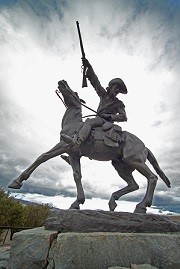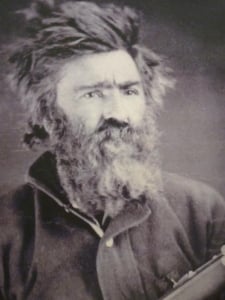
Living History in Cody Yellowstone
CODY, Wyo., March 29, 2019 – From the establishment of the world’s first national park to the creation of a once-raucous frontier town, the northwestern Wyoming destination of Cody Yellowstone has been making history for quite a long time.
“The past is an authentic part of a modern-day Cody Yellowstone adventure,” said Claudia Wade, director of the Park County Travel Council, the marketing arm for the region comprised of the towns of Cody, Meeteetse, Powell and the valley east of Yellowstone National Park. “From the Winchester rifles on display at the Cody Firearms Museum to the bull fighters who have been protecting Cody Nite Rodeo performers for generations, history plays a part in nearly every Cody experience.”
Here are some places and ways to experience the history that helped shape Cody Yellowstone’s character:
- Authentic Western-style furniture at By Western Hands Museum & Archives. Opening this summer, this multi-faceted facility is a testament to the creations of furniture artisan Thomas Molesworth and others who skillfully created functional furniture using elements found in nature and Western life.
- Collections of tribal artistry at the Plains Indian Museum, one of five Buffalo Bill Center of the West museums. This acclaimed museum includes creations of many Plains peoples such as eagle feather bonnets, bear claw necklaces, buffalo hide tipis and tipi furnishings, shields, cradles, peace medals and moccasins.
- Historic firearms at the Cody Firearms Museum and Dug Up Gun Museum. Tracing the history of firearms, and showcasing their craftsmanship and technological innovations can reveal much of how the country – and the world – has evolved, and that’s just what visitors will experience at these two downtown museums. The Cody Firearms Museum is nearing completion of a major renovation this summer that will feature its signature Winchester Firearms Collection as well as thousands of other firearms. The Dug Up Gun Museum is the work of a passionate collector, with displays of guns in varying conditions that have been dug up from farms, valleys and battlefields around the world.
- Paintings of the day-to-day life of an incarceree at Heart Mountain WWII Interpretive Center. This award-winning museum opened in 2011 and includes poignant exhibits of incarcerees at the internment camp. “All You Can Carry,” the introductory film at the center, includes the paintings of Estelle Ishigo, a Caucasian woman who chose to remain at her Japanese-American husband’s side when he was imprisoned during World War II. A talented artist, Ishigo chronicled the day-to-day lives of the camp’s 14,000 residents with sketches, drawings and watercolors depicting the brutal conditions of the camp and camp life.
- The Visitor Center at the Buffalo Bill Dam. Once the tallest concrete dam in the world and a National Civil Engineering Landmark, the Buffalo Bill Dam was
 operating before Buffalo Bill Cody’s death in 1917. The visitor center’s exhibits show how the dam fulfilled the forward-thinking showman’s goal to bring a reliable water source to the Bighorn Basin.
operating before Buffalo Bill Cody’s death in 1917. The visitor center’s exhibits show how the dam fulfilled the forward-thinking showman’s goal to bring a reliable water source to the Bighorn Basin.
- The Cherrywood bar at the Irma Hotel. In 1902, seven years after he founded the town of Cody, William F. “Buffalo Bill” Cody built the Irma Hotel on the town’s then main street – 12th Street – and named it after his youngest daughter. Listed on the National Register of Historic Places, the hotel’s famous room-long Cherrywood bar – still in use today in what is now the hotel dining room – was presented to Buffalo Bill by England’s Queen Victoria, who was charmed by Buffalo Bill and his Wild West Show when the company performed in London.
- “Buffalo Bill – The Scout” at the Buffalo Bill Center of the West. Created by famed New York sculptress Gertrude Vanderbilt Whitney, The Scout has greeted visitors to the Buffalo Bill Center of the West since 1924. The sculpture is mounted on a stone base that represents Cedar Mountain, where Buffalo Bill wished to be buried, and it was created at the behest of Caroline Lockhart, editor and publisher of the Cody Enterprise. The famous heiress funded the cost of the sculpture, and her son Cornelius later funded the creation of the Whitney Western Art Museum.
- Hemingway’s signature in the guest register at the Chamberlin Inn. In 1932 “Ernest Hemingway of Key West, Florida” had just completed the manuscript for Death in the Afternoon and was enjoying some time fishing the Clark’s Fork River by day and swapping stories with the locals in the Irma Bar at night. The register is displayed at the inn and open to the page containing Hemingway’s signature. And the room in which Hemingway stayed is available to overnight guests.
- Indian Trade Musket at the Cody Firearms Experience. Popular among firearms enthusiasts and history buffs alike, the Cody Firearms Experience provides visitors
 with a chance to shoot the guns that won the West in a safe, supervised and educational setting. Visitors can choose from a replica of an Indian Trade Musket, US Model 1795, Flintlock Musket, Colt Walker Revolver and Winchester Model 1873 Rifle and fire them in a state-of-the-art indoor shooting range.
with a chance to shoot the guns that won the West in a safe, supervised and educational setting. Visitors can choose from a replica of an Indian Trade Musket, US Model 1795, Flintlock Musket, Colt Walker Revolver and Winchester Model 1873 Rifle and fire them in a state-of-the-art indoor shooting range.
- Buffalo Bill’s hunting lodge, Pahaska Teepee. Located just outside the East entrance to Yellowstone National Park, Cody brought his hunting pals – including Theodore Roosevelt and the Prince of Monaco – to this rustic lodge. Cody was named “Long Hair” by American Indians in the region, which in their tongue was pronounced “Pahaska.” The rustic log lodge displays many gifts given to Cody by guests. Modern cabins, a restaurant and gift shop make this a great stop for travelers before they head into the park.
- Cabins and gravesites at Old Trail Town/Museum of the Old West. This enclave of 26 authentic frontier buildings includes one used by Butch Cassidy and his infamous Hole-in-the-Wall Gang. One of the town’s many gravesites belongs to Jeremiah “Liver Eating” Johnston – portrayed by actor Robert Redford in the 1972 film.
- The teller’s cage at Meeteetse Bank Museum. Butch Cassidy once lived in Meeteetse, and despite his reputation as a prolific and highly successful bank robber, he pledged not to rob the Meeteetse Bank so he and his friends would have a safe place to stash their ill-gotten cash. That bank is now the Meeteetse Bank Museum, and it still displays the original teller’s cage, vault and many other artifacts.
###
Home of the Great American Adventure, Cody Yellowstone is comprised of the northwestern Wyoming towns of Cody, Powell and Meeteetse as well as the valley east of Yellowstone National Park. The region is known for rodeos, authentic guest and dude ranches, world-class museums and recreational adventures that reflect the adventurous spirit of the visionaries and explorers who brought the remote region to the world’s attention.
Related hashtags: #YellowstoneCountry #CodyWyoming #CenteroftheWest #BuffaloBill #Yellowstone #ThatsWY
Media contact:
Mesereau Travel Public Relations
720-284-1512


